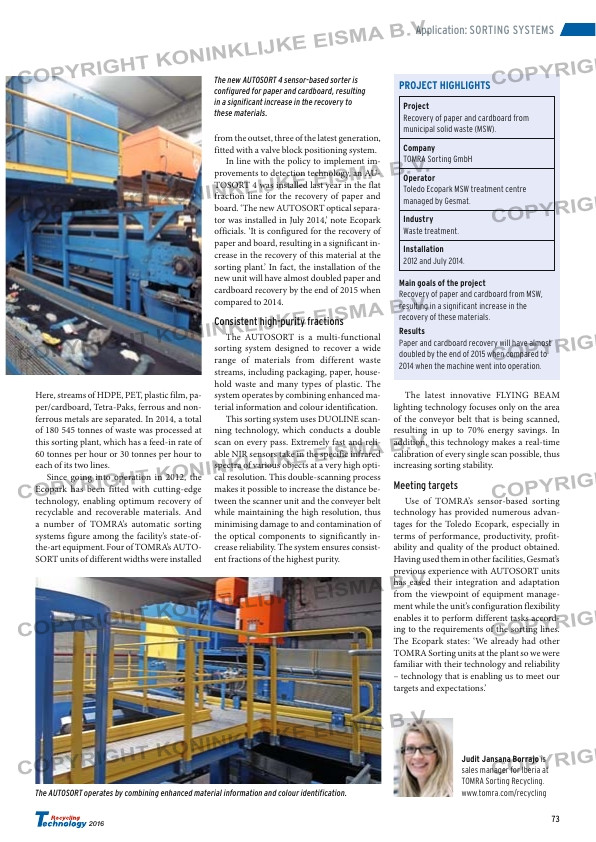Page 73 from: Recycling Technology 2016

73
2016
Application: SORTING SYSTEMS
Here, streams of HDPE, PET, plastic film, pa-
per/cardboard, Tetra-Paks, ferrous and non-
ferrous metals are separated. In 2014, a total
of 180 545 tonnes of waste was processed at
this sorting plant, which has a feed-in rate of
60 tonnes per hour or 30 tonnes per hour to
each of its two lines.
Since going into operation in 2012, the
Ecopark has been fitted with cutting-edge
technology, enabling optimum recovery of
recyclable and recoverable materials. And
a number of TOMRA’s automatic sorting
systems figure among the facility’s state-of-
the-art equipment. Four of TOMRA’s AUTO-
SORT units of different widths were installed
from the outset, three of the latest generation,
fitted with a valve block positioning system.
In line with the policy to implement im-
provements to detection technology, an AU-
TOSORT 4 was installed last year in the flat
fraction line for the recovery of paper and
board. ‘The new AUTOSORT optical separa-
tor was installed in July 2014,’ note Ecopark
officials. ‘It is configured for the recovery of
paper and board, resulting in a significant in-
crease in the recovery of this material at the
sorting plant.’ In fact, the installation of the
new unit will have almost doubled paper and
cardboard recovery by the end of 2015 when
compared to 2014.
Consistent high-purity fractions
The AUTOSORT is a multi-functional
sorting system designed to recover a wide
range of materials from different waste
streams, including packaging, paper, house-
hold waste and many types of plastic. The
system operates by combining enhanced ma-
terial information and colour identification.
This sorting system uses DUOLINE scan-
ning technology, which conducts a double
scan on every pass. Extremely fast and reli-
able NIR sensors take in the specific infrared
spectra of various objects at a very high opti-
cal resolution. This double-scanning process
makes it possible to increase the distance be-
tween the scanner unit and the conveyer belt
while maintaining the high resolution, thus
minimising damage to and contamination of
the optical components to significantly in-
crease reliability. The system ensures consist-
ent fractions of the highest purity.
The latest innovative FLYING BEAM
lighting technology focuses only on the area
of the conveyor belt that is being scanned,
resulting in up to 70% energy savings. In
addition, this technology makes a real-time
calibration of every single scan possible, thus
increasing sorting stability.
Meeting targets
Use of TOMRA’s sensor-based sorting
technology has provided numerous advan-
tages for the Toledo Ecopark, especially in
terms of performance, productivity, profit-
ability and quality of the product obtained.
Having used them in other facilities, Gesmat’s
previous experience with AUTOSORT units
has eased their integration and adaptation
from the viewpoint of equipment manage-
ment while the unit’s configuration flexibility
enables it to perform different tasks accord-
ing to the requirements of the sorting lines.
The Ecopark states: ‘We already had other
TOMRA Sorting units at the plant so we were
familiar with their technology and reliability
– technology that is enabling us to meet our
targets and expectations.’
PROJECT HIGHLIGHTS
Project
Recovery of paper and cardboard from
municipal solid waste (MSW).
Company
TOMRA Sorting GmbH
Operator
Toledo Ecopark MSW treatment centre
managed by Gesmat.
Industry
Waste treatment.
Installation
2012 and July 2014.
Main goals of the project
Recovery of paper and cardboard from MSW,
resulting in a significant increase in the
recovery of these materials.
Results
Paper and cardboard recovery will have almost
doubled by the end of 2015 when compared to
2014 when the machine went into operation.
Judit Jansana Borrajo is
sales manager for Iberia at
TOMRA Sorting Recycling.
www.tomra.com/recycling
The new AUTOSORT 4 sensor-based sorter is
configured for paper and cardboard, resulting
in a significant increase in the recovery to
these materials.
The AUTOSORT operates by combining enhanced material information and colour identification.



